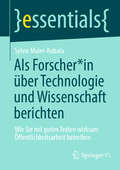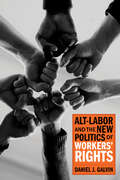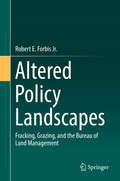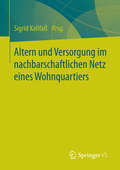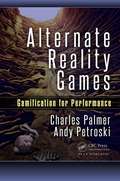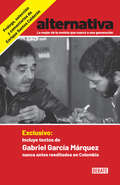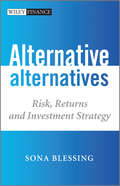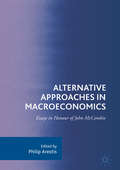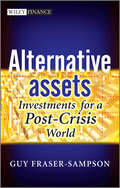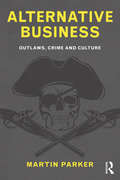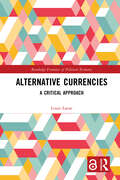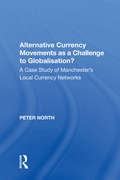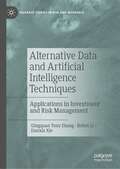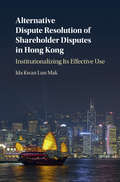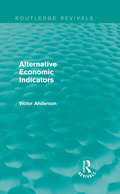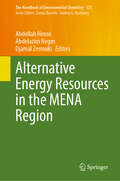- Table View
- List View
Als Forscher*in über Technologie und Wissenschaft berichten: Wie Sie mit guten Texten wirksam Öffentlichkeitsarbeit betreiben (essentials)
by Sylvie Maier-KubalaIn diesem essential erfahren Sie, wie Sie als Forscher*in ansprechende Texte über Ihre Arbeit schreiben, die Aufmerksamkeit in der Öffentlichkeit generieren. Sie erhalten eine Einordnung, welche Inhalte sich für Wissenschaftskommunikation eignen und wie es Ihnen gelingt, komplexe Themen auf ihre Essenz zu reduzieren. Im Band finden Sie zudem eine Anleitung, wie Sie Texte sinnvoll strukturieren und Sprache und Stil an Ihre Zielgruppe anpassen. Sie erhalten wertvolle Tipps, wie Sie Ihre Texte so planen und veröffentlichen, damit sie in der allgemeinen Informationsflut nicht untergehen. Zahlreiche Übungen aus dem kreativen Schreiben runden die einzelnen Kapitel ab, von der Ideenfindung bis zum fertigen Text.
Als gäbe es keine Schwerkraft: Leadership durch die Augen eines Tänzers
by Bernd PreuschoffDieses Buch ist nicht nur eine Hommage an das Tanzen, sondern vor allem auch an das wertschätzende Führen von Menschen. Denn je mehr es, gerade in modernen digitalen Zeiten, um das Erreichen von kreativen und innovativen Spitzenleistungen geht, desto offensichtlicher werden die Parallelen zwischen Kunst als Leistungssport und Performance im Management. Ein erfolgreiches Agieren in einer sich permanent verändernden Welt stellt neue Anforderungen an Führungskräfte und fordert sie mehr als je zuvor als Mensch und Persönlichkeit – warum also nicht von denjenigen lernen, für die wahre Emotionen, erfolgreiche Führung und leicht anmutende Bewegung elementare Bestandteile der eigenen Darbietung sind? Erzählt von einem versierten Kenner beider Welten, ist das Buch die Einladung an jeden Entscheider in Unternehmen, die eigene Verantwortung und vor allem die eigenen Handlungsmöglichkeiten aus einem neuen Blickwinkel zu sehen – nämlich durch die Augen eines Tänzers. Mit zwei neuen Kapiteln für die zweite Auflage: Über mentale Stärke und ihre Rolle bei erfolgreicher Führung, sowie über "Unmöglich-Mythen" und wie man sie entzaubert.
Alt - Krank - Blank?: Worauf es im Alter wirklich ankommt
by Christian Hentschel Matthias BettermannDieses gut verständliche Werk bringt Licht ins Dunkel des komplizierten wirtschaftlichen Themas Rente und Vorsorge und erklärt die wichtigsten Dinge, von denen heutzutage auch ein nicht studierter Ökonom wissen sollte. Und es regt an zu einem neuen Mittel der Vorsorge gegen Armut im Alter: dem Erhalt von Familie, Partnerschaft und Freundschaft. Den einzigen Dingen im Leben, die man sich nicht kaufen kann. . . Freuen Sie sich auf eine Lektüre, die Ihnen in dieser Kombination eine besondere Hilfestellung zur Vorsorge im Alter bietet.
Alt-Labor and the New Politics of Workers' Rights
by Daniel J. GalvinOver the last half century, two major developments have transformed the nature of workers’ rights and altered the pathways available to low-wage workers to combat their exploitation. First, while national labor law, which regulates unionization and collective bargaining, has grown increasingly ineffective, employment laws establishing minimal workplace standards have proliferated at the state and local levels. Second, as labor unions have declined, a diversity of small, under-resourced nonprofit “alt-labor” groups have emerged in locations across the United States to organize and support marginalized workers. In Alt-Labor and the New Politics of Workers’ Rights, political scientist Daniel J. Galvin draws on rich data and extensive interviews to examine the links between these developments. With nuance and insight, Galvin explains how alt-labor groups are finding creative ways to help their members while navigating the many organizational challenges and structural constraints they face in this new context. Alt-labor groups have long offered their members services and organizing opportunities to contest their unfair treatment on the job. But many groups have grown frustrated by the limited impact of these traditional strategies and have turned to public policy to scale up their work. They have successfully led campaigns to combat wage theft, raise the minimum wage, improve working conditions, strengthen immigrants’ rights, and more. These successes present something of a puzzle: relative to their larger, wealthier, and better-connected opponents, alt-labor groups are small, poor, and weak. Their members are primarily low-wage immigrant workers and workers of color who are often socially, economically, and politically marginalized. With few exceptions, the groups lack large dues-paying memberships and are dependent on philanthropic foundations and other unpredictable sources of funding. How, given their myriad challenges, have alt-labor groups managed to make gains for their members? Galvin reveals that alt-labor groups are leveraging their deep roots in local communities, their unique position in the labor movement, and the flexibility of their organizational forms to build their collective power and extend their reach. A growing number of groups have also become more politically engaged and have set out to alter their political environments by cultivating more engaged citizens, influencing candidate selection processes, and expanding government capacities. These efforts seek to enhance alt-labor groups’ probabilities of success in the near term while incrementally shifting the balance of power over the long term. Alt-Labor and the New Politics of Workers’ Rights comprehensively details alt-labor’s turn to policy and politics, provides compelling insights into the dilemmas the groups now face, and illuminates how their efforts have both invigorated and complicated the American labor movement.
Altas Finanzas: Los Secretos Wue Wall Street No Quiere Que Usted Sepa
by Logan C. KaneBest seller internacional. Altas Finanzas ha ayudado a miles de personas a voltear las mesas en Wall Street, no solo en Estados Unidos y Canadá, sino también en otros 17 países, como Francia, Alemania, Hungría, Corea del Sur y China. El tema principal del libro es que Wall Street supera a los inversores minoristas a través de una serie de pequeñas ventajas, como comisiones, tarifas, márgenes de oferta / demanda e intereses de margen, muy parecidos a la ventaja de la casa en el casino o la casa de apuestas. Puede identificar dónde están estos márgenes y evitarlos. Al controlar sus gastos, tiene muchas más posibilidades de obtener ganancias sustanciales, ya sea que negocie o invierta a largo plazo. Hay muchos detractores que dirán que es imposible que gane dinero en el mercado de valores. Están equivocados. Ya sea que elija aumentar constantemente su capital a través de una inversión prudente y de bajo costo o al repartir un comercio rentable tras otro rentable, es capaz de alcanzar sus objetivos si comprende cómo funciona el sistema. No hay escasez de dinero en este mundo; el dinero simplemente no se distribuye por igual. Hay gente que puede vivir en cada mansión y ático en todo el mundo, ¿y si pudieras ser tú? La inversión y el comercio inteligentes pueden generarle más dinero del que jamás haya soñado; más rápido de lo que creía posible. El 90 por ciento de los inversores pierde dinero o solo alcanza el equilibrio. ¡Mereces más! Los tiburones de Wall Street tienen un suministro constante de peces, y este libro es solo una gota en el océano. Sin embargo, como estás leyendo, te estás uniendo al lado ganador. Aprende cómo funciona el juego, cuáles son las reglas y cómo puedes ganar. Adentro: Ejemplos de acciones ganadoras y operaciones de opciones realizadas por el autor y cómo puede replicarlas. Por qué las comisiones y las tarifas son el obstáculo número uno que enfrentan la mayoría de los inversores y comerciantes, y cómo pu
Altered Policy Landscapes: Fracking, Grazing, and the Bureau of Land Management
by Robert E. Forbis Jr.This book documents the United States Bureau of Land Management's (BLM) shift from a rancher-dominated agency to an energy-dominated agency. This shift is analyzed by identifying the conditions under which the expansion of hydraulic fracturing (fracking) in the Rocky Mountain West triggered a political conflict between ranching and energy stakeholder groups. Through scrutiny of federal actions and policies implemented by the Executive Branch between 2004 and 2010, the book sheds light on the emphasis of domestic energy production during this time period, and how the traditional ranching and energy alliance was split by shifting policy interests. The book is meant for policy makers, natural resource agencies, and students and researchers engaged in political science, public administration, and natural resource management. Chapter 1 introduces readers to the case study at hand, and reviews literature on public land agencies and policies. Chapter 2 summarizes the legal history of public land management by the federal government, and the conditions that caused the BLM to favor energy development over ranching in the mid-2000's. Chapter 3 details the role of the Executive Branch (Bush-Cheney administration) in affecting the BLM's domestic energy policies and resource allocation, and chapter 4 analyzes the role of subgovernments in affecting the BLM's motivations too. Chapters 5, 6 and 7 contain first-hand accounts from government officials, state petroleum associations, and ranching supported interest groups to explore the concept of subgovernment stakeholder domination in policymaking, and analyze the similarities and differences between different policy-making elites. Chapter 8 concludes the text by summarizing subgovernment theory, mapping the behaviors of subgovernment actors, and discussing the implications for future political appointees in the direction of land-management agencies like the BLM.
Altering Frontiers: Organizational Innovations in Healthcare
by Ewan Oiry Corinne GrenierHow can healthcare systems be transformed by reimagining their multiple silos to favor processes and practices that are more responsive to local, horizontal initiatives? Altering Frontiers analyzes numerous experiences, using a multidisciplinary approach, paying attention to certain actors, collectives and organizational arrangements.Through this work, levers are identified that promote lasting transformation: recognizing the legitimacy of the practices of many who are often "invisible"; trusting those who know their intervention territory; investing in methodological support; taking advantage of tools and procedures such as instruments for strategic and managerial discussion; and developing the capacity to absorb innovative ideas and experiences that circulate within the environment.
Altern und Versorgung im nachbarschaftlichen Netz eines Wohnquartiers: Zur Kooperation eines Altenhilfeträgers und einer Wohnbaugenossenschaft bei der quartiersbezogenen Gemeinwesenarbeit
by Sigrid KallfaßDiese Publikation beinhaltet die Ergebnisse des vom Bundesministeriums für Bildung und Forschung geförderten Projekts ,,Altern und Versorgung im nachbarschaftlichen Netz einer Wohnbaugenossenschaft". Die umfassende Studie liefert wichtige Aspekte zur Förderung einer Generationenbeziehung im nachbarschaftlichen Kontext.
Alternate Reality Games: Gamification for Performance
by Charles Palmer Andy PetroskiWhile formal training and communication are a foundational approach to developing employees in the workplace, alternate reality games (ARGs) provide a framework for increased and sustained engagement within business organizations. ARGs are transmedia experiences designed to generate engagement and immersive learning beyond what is achieved in forma
Alternativa
by Varios AutoresEnrique Santos Calderón selecciona los mejores artículos, reportajes, caricaturas, portadas, editoriales, columnas y entrevistas, de la revista que cambió la forma de hacer periodismo en Colombia La revista Alternativa fue fundada a comienzos de los años setenta por Gabriel García Márquez y Enrique Santos Calderón, entre otros. Con su aparición, se dio forma a un periodismo comprometido y militante que poco se conocía en Colombia. Este libro es un homenaje a la revista y con la selección y comentarios de Enrique Santos Calderón, quien fue su director, se presenta un intenso retrato del país que siguió al Frente Nacional, de los conflictos que asomaron en esa época y que heredamos en el presente. La publicación congregó a un grupo conformado por Orlando Fals Borda, Bernardo García, Antonio Caballero, Daniel Samper Pizano, Álvaro Tirado Mejía y varios más que influirían de manera significativa en la opinión pública colombiana. De tal suerte, la selección que aquí presentamos es la reunión de verdaderas joyas. A los textos del Nobel, muchos de ellos por primera vez reeditados en el país, se sumaron, por ejemplo, entrevistas exclusivas a Botero, Cortázar y Dalí; perfiles de León de Greiff, Capax y Ardila Lülle; la crónica del paro nacional de 1977 o las revelaciones del fiscal que llevó el caso del asesinato de Gaitán. Una Colombia extensa, profunda y diversa, que reclamaba cambios de fondo reaparece en estas páginas, como un espejo del momento actual.
Alternative Acquisition Models and Financial Innovation: Special Purpose Acquisition Companies in Europe, and the Italian Legal Framework (Routledge International Studies in Money and Banking)
by Yochanan Shachmurove Daniele D’Alvia Ettore Maria LombardiThis is the first book written in English on special purpose acquisition companies (SPACs) in the context of European and Italian financial law, introducing the topic with a general overview on the European stage. It is also the first book on European financial regulations of SPACs. As such, it is a groundbreaking reference text for SPAC studies at the international level. Alternative Acquisition Models and Financial Innovation: Special Purpose Acquisition Companies in Europe, and the Italian Legal Framework offers the most comprehensive overview of the current international financial regulations of SPACs in the EU and UK compared to the main legal system where SPACs originated—the US. This edited book is focused on finding a European legal framework for SPACs by discovering whether the Alternative Investment Fund Managers Directive (AIFMD) or the Undertakings for the Collective Investment in Transferable Securities Directive (UCITS) are applicable to them and why, as well as identifying the objectives of financial regulation of SPACs in the EU, US and UK. Essentially, the edited collection explores soft law and self-regulation instances against the state-based Westphalian approaches centred on hard law instances; describes practical examples of SPACs in Italy and Europe; and analyses the limits and perspectives of such investment vehicles on the Italian capital market as well as their possible uses as forms of shadow banking and venture companies at international levels.
Alternative Alternatives
by Sona BlessingIn the aftermath of the financial crisis, investors are searching for new opportunities and products to safeguard their investments for the future. Riding high on the wave of new financial opportunities are Alternative Alternatives (AA). However, there is a dearth of information on what Alternative Alternatives are, how they work, and how they can be profited from.The book defines what Alternative Alternatives are, based on research and the following hypothesis: If the source (origin) of the risk lies outside of the financial markets, then it should be insulated from the vagaries of those markets. The book identifies and examines such and other unique, idiosyncratic, and difficult to replicate sources of risk - assets and strategies. The recent credit and sovereign debt crisis have served to defend the hypothesis and have upheld the conclusion that alternative alternative assets and strategies offer a risk-return profile that is distinct to those offered by traditional and main stream hedge fund strategies. These strategies include timberland investing, insurance risk transfer, asset/loan based lending (aviation, shipping, trade, entertainment, litigation financing etc), collectables and extraction strategies such as volatility and behaviour finance.This book will be a one stop resource to the new investment class known globally as Alternative Alternatives (AA) and will provide a comprehensive but accessible introduction to these assets. It provides an in-depth analysis of the assets and strategies which will leave investors with everything they need to identify and allocate to the best AA for them. It reviews the asset on a standalone basis, providing an explanation of the product, its characteristics, a SWOT analysis, and details its risk/reward drivers. The book also looks at how to integrate the asset within a portfolio - its peculiarities, the challenges and the constraints of each. Next, the book shows how Alternative Alternatives are used in the real world, how they are implemented, and the results that they have achieved. Finally, the book looks at the scope, scalability and prospects for each asset in the future.
Alternative Approaches in Macroeconomics: Essays in Honour of John McCombie
by Philip ArestisThis book honours Professor John McCombie’s retirement by exploring a variety of themes, theories and debates in non-orthodox macroeconomics. With contributions from leading scholars, the book covers diverse ground in economic thought, policy, empirical work and modelling. It demonstrates ongoing presumptions and asks probing questions of topical questions from the increase of income equality to the international variation of productivity investment. This collection will appeal to academics and students with an interest in the history of macroeconomic thinking.
Alternative Approaches to Economic Theory: Complexity, Post Keynesian and Ecological Economics (Routledge Frontiers of Political Economy)
by Victor A. BekerThe 2007–2008 financial crisis exposed the shortcomings of mainstream economic theory with economists unprepared to deal with it. In the face of this, a major rethinking of economics seems necessary and in presenting alternative approaches to economic theory, this book contributes to the rebuilding of the discipline. This volume brings together contributions from different perspectives and theoretical approaches that address the challenge of updating the economic theory corpus and seek to recover prestige for this discipline after the failure of neoclassical economics. It addresses a range of topics, including the complexity approach to economics, category theory, the Post-Keynesian approach to micro and macroeconomics, financialisation, multidimensional analysis and ecological economics. The book is aimed at economics scholars, researchers, academics and practitioners, as well as upper undergraduates and graduates in this area of knowledge. It may also be of interest for people interested in methodological issues in economics and the relationship between economic theory and the real world.
Alternative Assets
by Guy Fraser-SampsonThe investment landscape has changed dramatically over the last few years, destroying many of the old certainties by which investors lived their lives. In particular, it has shaken belief in the ability of traditional asset types such as bonds and equities to protect them from abnormal market conditions, and it has brought home how closely correlation between different markets can be squeezed together by extreme pressure.Future investors will have to regard so-called "alternative" assets as essential elements within their portfolios, and be prepared to deal with the complexities that this will entail. This will in turn force a re-appraisal of core concepts such as "risk" and "return", not least because some alternative asset classes do not lend themselves well to traditional return measures. Exciting times lie ahead, but a thorough working knowledge of the various alternative asset classes will be an essential pre-requisite to success, and perhaps even to survival.Alternative Assets meets investor's need for a guide on where to allocate in this new climate. It provides investors with a primer on each alternative asset class, as well as practical tips on the pros and cons, implementation, returns analysis, fees and costs. It also offers introductory guidance on how to set investment targets, and how alternative assets can be accommodated within the allocation process. Each chapter gives useful background knowledge on a particular asset type, including a discussion of whether a satisfactory beta return level exists and, if so, the different ways in which it might be accessed.Written by best-selling author Guy Fraser-Sampson, this book guides investors through the new look alternative investment arena, providing post-financial crisis perspective and investment advice on the alternatives landscape.
Alternative Assets and Strategic Allocation: Rethinking the Institutional Approach (Bloomberg #134)
by John B. AbbinkAn insightful guide to making strategic investment allocation decisions that embraces both alternative and conventional assets In this much-needed resource, alternative and portfolio management expert John Abbink demonstrates new ways of analyzing and deploying alternative assets and explains the practical application of these techniques. Alternative Assets and Strategic Allocation clearly shows how alternative investments fit into portfolios and the role they play in an investment allocation that includes traditional investments as well. This book also describes innovative methods for valuation as applied to alternatives that previously have been difficult to analyze. Offers institutional investors, analysts, researchers, portfolio managers, and financial academics a down-to-earth method for measuring and analyzing alternative assets Reviews some of the latest alternatives that are increasing in popularity, such as high-frequency trading, direct lending, and long-term investment in real assets Outlines a strategic approach for including alternative investments into portfolios and shows the pivotal role they play in an investment allocation Using the information found in this book, you'll have a clearer sense of how to approach investment issues related to alternative assets and discover what it takes to make these products work for you.
Alternative Banking and Financial Crisis (Banking, Money and International Finance #1)
by Olivier Butzbach Kurt Von MettenheimThe recent banking crisis has brought into question the business model used by most large banks. This collection of essays explores the success of ‘alternative banks’ – savings banks, cooperative banks and development banks, using case studies from around the world and discussion of both the historical and theoretical context of banking practices.
Alternative Business: Outlaws, Crime and Culture (Routledge Companions In Business, Management And Accounting Ser.)
by Martin ParkerFrom Robin Hood to Jack Sparrow from Pirates of the Caribbean, outlaws have been a central part of 800 years of culture. These are characters who criticise the power of those in the castle or the skyscraper, and earn their keep by breaking the law. Outlaws break categories too. They are fact and fiction, opposition and product, culture and economy, natural justice and organized crime. Beginning with Robin Hood stealing from the rich, and covering along the way pirates, smugglers, highwaymen, the Wild West, the Mafia and many others, Martin Parker offers a fresh and exciting insight into the counter culture of the outlaw – one that rebels against the more dominant and traditional forms of economy and organization and celebrates a life free from wage slavery. Alternative Business is a highly readable, entertaining book that will prove a helpful study tool for all students and lecturers working on organizations, cultural studies and criminology.
Alternative Currencies: A Critical Approach (Routledge Frontiers of Political Economy)
by Louis LarueA wide variety of new forms of money have been developed in recent decades as a challenge or complement to the official, dominant currencies. LETS, local currencies, carbon currencies, and Bitcoins are all examples of this new trend. These currencies are at the heart of a larger movement that questions the present state of money and argues that new currencies might help to build resilient economies and “warmer” social relations.This book focuses on radical alternative proposals as well as on small-scale experiments, and makes use of the analytical tools of philosophy and of economics, with one main question in mind: can alternative currencies constitute desirable alternatives to the present monetary system? Overall, the book will raise serious doubts regarding the capacity of such currencies to deliver on their promises. In part, it will show that several arguments in favour of alternative currencies are lacking in consistency and clarity, and are thus in need of thorough revision. More fundamentally, it will argue that these currencies rarely succeed in fulfilling their objectives and that their fulfilment would entail significant conflicts with justice and economic efficiency.This book is addressed to researchers in economics, politics, and philosophy of money, especially those working on alternative monetary systems.
Alternative Currency Movements as a Challenge to Globalisation?: A Case Study of Manchester's Local Currency Networks (Ashgate Economic Geography Ser.)
by Peter NorthOver the past 15 years, local money networks, which are essentially trading networks using a community-created currency, have emerged in countries as far apart as Argentina, Australia and New Zealand, Canada and the US, continental Europe and Japan. They range from Local Exchange Trading Schemes (UK), to Time Dollars (US), Green Dollars (New Zealand, Australia and Canada), Trading Circles (Hungary), Barter Networks (Argentina) and Talents (Germany). Drawing on an ethnographic case study of alternative currency movements in Manchester, UK, this book provides an analysis of the motivations, aims, successes and failures of alternative currency networks. It also raises questions such as the contribution of the alternative currency movement to current debates about alternatives to neoliberalism. While it is theoretically informed, critical and grounded in fieldwork, it is also sympathetic to the political aims of the protagonists and cognisant of the non-economic benefits that arise from their development.
Alternative Data and Artificial Intelligence Techniques: Applications in Investment and Risk Management (Palgrave Studies in Risk and Insurance)
by Beibei Li Qingquan Tony Zhang Danxia XieThis book introduces a state-of-art approach in evaluating portfolio management and risk based on artificial intelligence and alternative data. The book covers a textual analysis of news and social media, information extraction from GPS and IoTs data, and risk predictions based on small transaction data, etc. The book summarizes and introduces the advancement in each area and highlights the machine learning and deep learning techniques utilized to achieve the goals. As a complement, it also illustrates examples on how to leverage the python package to visualize and analyze the alternative datasets, and will be of interest to academics, researchers, and students of risk evaluation, risk management, data, AI, and financial innovation.
Alternative Dispute Resolution of Shareholder Disputes in Hong Kong: Institutionalizing Its Effective Use
by Mak Ida Kwan LunThe landscape of shareholder dispute resolution in Hong Kong has changed vastly since the launch of the Civil Justice Reform in 2009. Key initiatives - the voluntary court-connected scheme and reform of the statutory unfair prejudice provisions - were employed to promote the greater use of alternative dispute resolution (ADR) in shareholder disputes. While the Hong Kong government and judiciary introduced such schemes to prove the legitimacy of extra-judicial over court-based litigation processes, their success is still uncertain. In this book, socio-legal theory and sociological institutionalism are used to develop a theoretical framework for analyzing the key stages of institutionalization. The author analyzes how procedural innovations could acquire legitimacy through different types of legal and non-legal inducement mechanisms within the institutionalization process. Recommendations on codifying and innovating ADR policy in Hong Kong shareholder disputes made with comparison to similar policies in the United Kingdom, South Africa and New Zealand.
Alternative Economic Indicators (Routledge Revivals)
by Victor AndersonThe main objective of politicians is to maximise economic growth, which heavily drives political policy and decision-making. Critics of the maximisation of growth as the central aim of economic policy have argued that growth in itself is not necessarily a good thing, particularly for the environment; however, what would replace the system and how it would be measured are questions that have been rarely answered satisfactorily. First published in 1991, this book was the first to lay out an entirely new set of practical proposals for developing new economic measurement tools, with the aim of being sustainable, ‘green’ and human-centred. Victor Anderson proposes that a whole set of indicators, rather than a single one, should play all the roles that GNP (Gross National Product) is responsible for. With a detailed overview of the central debates between the advocates and opponents of continued economic growth and an analysis of the various proposals for modification, this title will be of particular value to students interested in the diversity of measurement tools and the notion that economies should also be evaluated by their social and environmental consequences.
Alternative Energy Resources in the MENA Region (The Handbook of Environmental Chemistry #131)
by Abdelazim Negm Abdellah Henni Djamal ZerroukiThis book outlines the development of renewable energies in the Middle East and North Africa, it offers up-to-date information about their variability, availability and utilization, and serves as a guide for understanding the MENA renewable energy potential. Readers will find an authoritative discussion about the implementation of renewable energies, trends and forecast of solar, wind and geothermal systems applications in this region. Case studies from China, Mexico and Vietnam are also included in this book to foster the implementation of renewable energies in the MENA region. The MENA region is known for its immense oil, petroleum and gas reserve, being one of the most important regions in the world for fossil energy accessibility and, hence, for the global economic stability. This region holds at the same time the world’s greatest potential for renewable energy and over the past few years it has been receiving national and international political support for promoting the future of solar and wind power energies. However, can the region go green taking into account the availability of the natural resources? Expert contributors from countries such as United Arab Emirates, Egypt, Algeria, Turkey, and Morocco provide their perspective on this challenge and offer a comprehensive overview of the latest pilot projects for renewable energy in the region. This book will appeal to researchers, students, engineers and policymakers interested in the potential of alternative energy resources in the MENA region.
